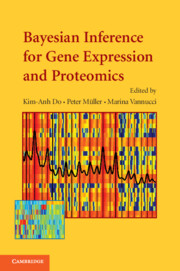Book contents
- Frontmatter
- Contents
- List of Contributors
- Preface
- 1 An Introduction to High-Throughput Bioinformatics Data
- 2 Hierarchical Mixture Models for Expression Profiles
- 3 Bayesian Hierarchical Models for Inference in Microarray Data
- 4 Bayesian Process-Based Modeling of Two-Channel Microarray Experiments: Estimating Absolute mRNA Concentrations
- 5 Identification of Biomarkers in Classification and Clustering of High-Throughput Data
- 6 Modeling Nonlinear Gene Interactions Using Bayesian MARS
- 7 Models for Probability of Under- and Overexpression: The POE Scale
- 8 Sparse Statistical Modelling in Gene Expression Genomics
- 9 Bayesian Analysis of Cell Cycle Gene Expression Data
- 10 Model-Based Clustering for Expression Data via a Dirichlet Process Mixture Model
- 11 Interval Mapping for Expression Quantitative Trait Loci
- 12 Bayesian Mixture Models for Gene Expression and Protein Profiles
- 13 Shrinkage Estimation for SAGE Data Using a Mixture Dirichlet Prior
- 14 Analysis of Mass Spectrometry Data Using Bayesian Wavelet-Based Functional Mixed Models
- 15 Nonparametric Models for Proteomic Peak Identification and Quantification
- 16 Bayesian Modeling and Inference for Sequence Motif Discovery
- 17 Identification of DNA Regulatory Motifs and Regulators by Integrating Gene Expression and Sequence Data
- 18 A Misclassification Model for Inferring Transcriptional Regulatory Networks
- 19 Estimating Cellular Signaling from Transcription Data
- 20 Computational Methods for Learning Bayesian Networks from High-Throughput Biological Data
- 21 Bayesian Networks and Informative Priors: Transcriptional Regulatory Network Models
- 22 Sample Size Choice for Microarray Experiments
- Plate section
13 - Shrinkage Estimation for SAGE Data Using a Mixture Dirichlet Prior
Published online by Cambridge University Press: 23 November 2009
- Frontmatter
- Contents
- List of Contributors
- Preface
- 1 An Introduction to High-Throughput Bioinformatics Data
- 2 Hierarchical Mixture Models for Expression Profiles
- 3 Bayesian Hierarchical Models for Inference in Microarray Data
- 4 Bayesian Process-Based Modeling of Two-Channel Microarray Experiments: Estimating Absolute mRNA Concentrations
- 5 Identification of Biomarkers in Classification and Clustering of High-Throughput Data
- 6 Modeling Nonlinear Gene Interactions Using Bayesian MARS
- 7 Models for Probability of Under- and Overexpression: The POE Scale
- 8 Sparse Statistical Modelling in Gene Expression Genomics
- 9 Bayesian Analysis of Cell Cycle Gene Expression Data
- 10 Model-Based Clustering for Expression Data via a Dirichlet Process Mixture Model
- 11 Interval Mapping for Expression Quantitative Trait Loci
- 12 Bayesian Mixture Models for Gene Expression and Protein Profiles
- 13 Shrinkage Estimation for SAGE Data Using a Mixture Dirichlet Prior
- 14 Analysis of Mass Spectrometry Data Using Bayesian Wavelet-Based Functional Mixed Models
- 15 Nonparametric Models for Proteomic Peak Identification and Quantification
- 16 Bayesian Modeling and Inference for Sequence Motif Discovery
- 17 Identification of DNA Regulatory Motifs and Regulators by Integrating Gene Expression and Sequence Data
- 18 A Misclassification Model for Inferring Transcriptional Regulatory Networks
- 19 Estimating Cellular Signaling from Transcription Data
- 20 Computational Methods for Learning Bayesian Networks from High-Throughput Biological Data
- 21 Bayesian Networks and Informative Priors: Transcriptional Regulatory Network Models
- 22 Sample Size Choice for Microarray Experiments
- Plate section
Summary
Abstract
Serial analysis of gene expression (SAGE) is a technique for estimating the gene expression profile of a biological sample. Any efficient inference in SAGE must be based upon efficient estimates of these gene expression profiles, which consist of the estimated relative abundances for each mRNA species present in the sample. The data from SAGE experiments are counts for each observed mRNA species, and can be modeled using a multinomial distribution with two characteristics: skewness in the distribution of relative abundances and small sample size relative to the dimension. As a result of these characteristics, a given SAGE sample will fail to capture a large number of expressed mRNA species present in the tissue. Standard empirical estimates of the relative abundances effectively ignore these missing, unobserved species, and consequently tend to also overestimate the abundance of the scarce observed species comprising a vast majority of the total. In this chapter, we review a new Bayesian procedure that yields improved estimates for the missing and scarce species without trading off much efficiency for the abundant species. The key to the procedure is the mixture Dirichlet prior, which stochastically partitions the mRNA species into abundant and scarce strata, with each stratum modeled with its own multivariate prior, a scalar multiple of a symmetric Dirichlet. Simulation studies demonstrate that the resulting shrinkage estimators have efficiency advantages over the maximum likelihood estimator for SAGE scenarios simulated.
Introduction
Serial analysis of gene expression (SAGE) is a method for estimating the gene expression profile of a biological sample of interest. In this chapter, we review a method introduced in Morris, Baggerly, and Coombes (2003) for obtaining Bayesian shrinkage estimates of these profiles using a fully specified probability model.
- Type
- Chapter
- Information
- Bayesian Inference for Gene Expression and Proteomics , pp. 254 - 268Publisher: Cambridge University PressPrint publication year: 2006
- 2
- Cited by



